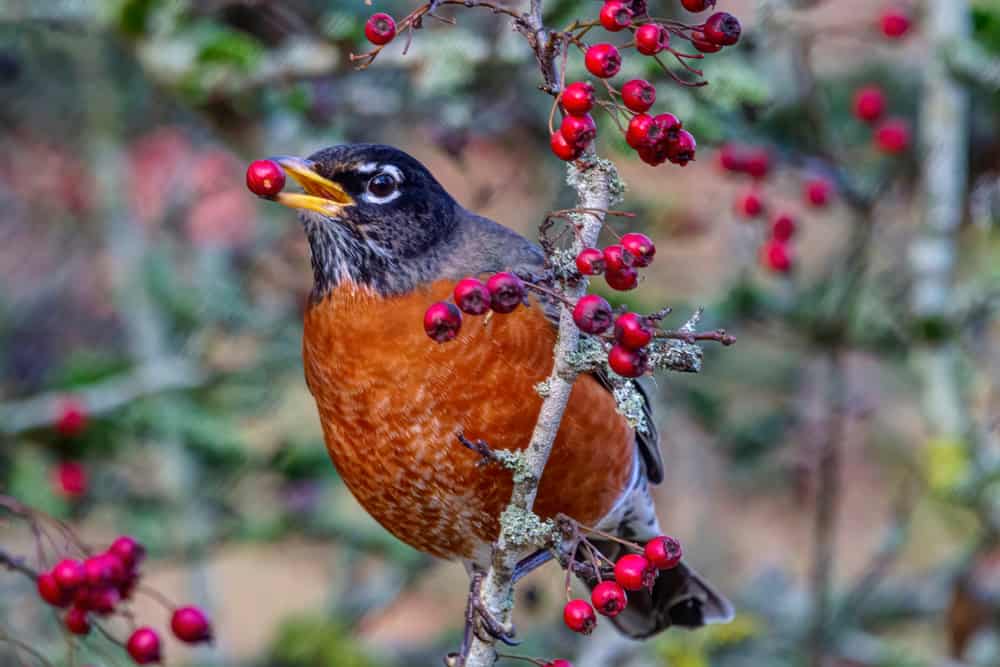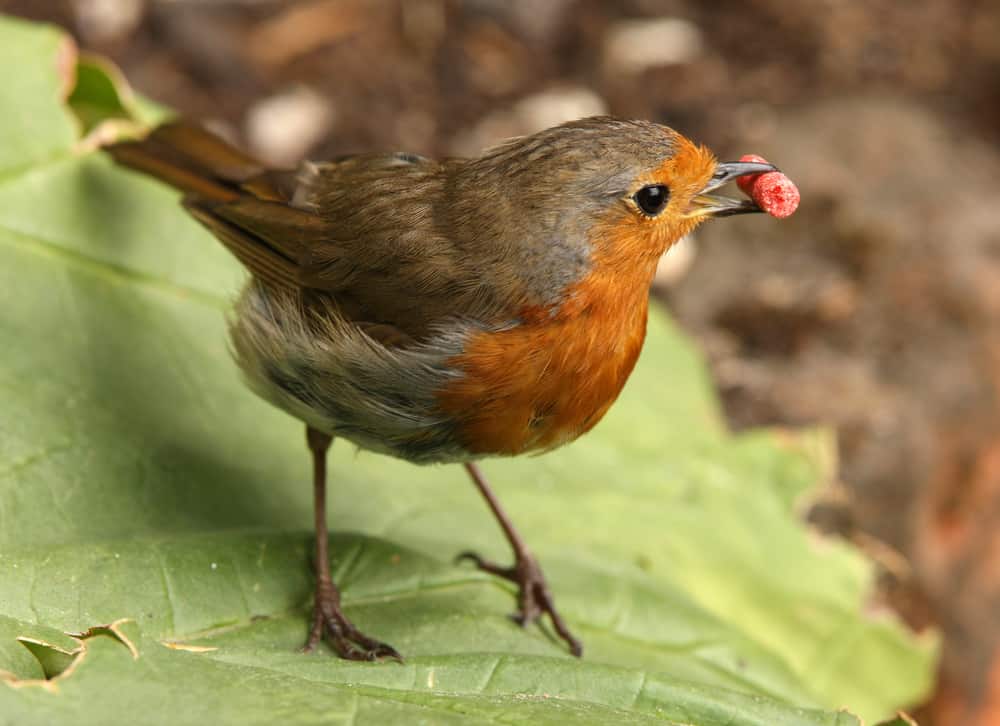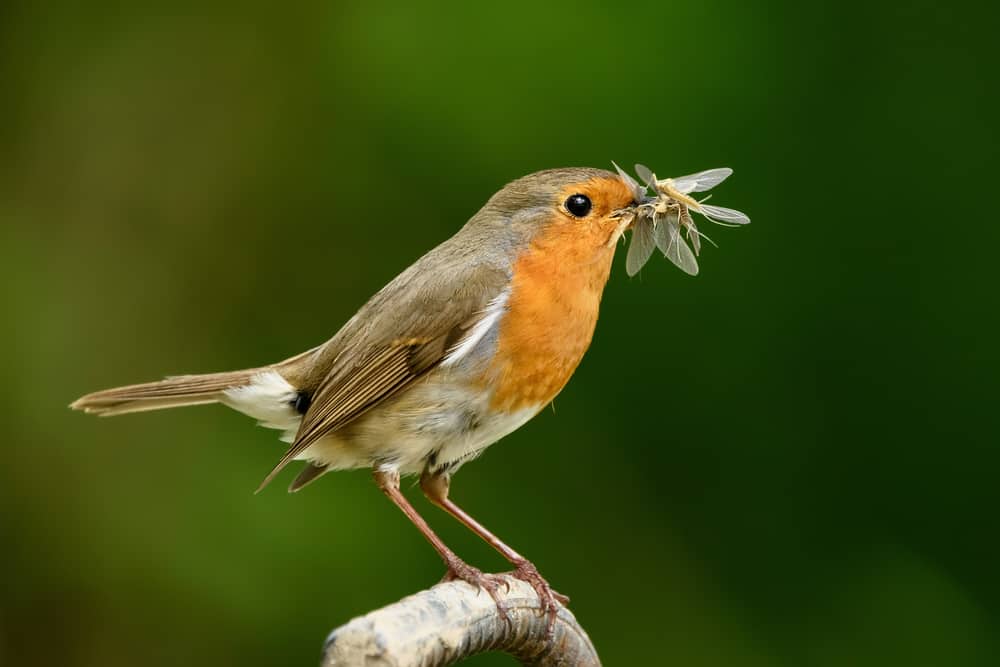Robins are the most famous songbirds with two known representatives, American and European species. Both have characteristic reddish-orange chests. Although you can often see them in your backyard, they are not frequent visitors to bird feeders. Let’s see what do Robins eat.
Robins Habits and Biology
American robins
American robins are the most widespread bird species and are present throughout the US. Since they are migratory birds, they reach Alaska in summer and southern Mexico and Guatemala in winter.
This bird species is active during the day when it mostly moves alone in food search. However, these birds prefer gathering in large flocks during the night when the winter comes.
During the nesting season in summer, they are very territorial and mostly spend time in pairs. However, they will unite to defend themselves from predators even during that period.
They feed primarily on the ground, looking for worms and earthworms. You can see them running across the lawn and pull a worm or earthworm out of the ground when spotting them.
American robins are early risers that start singing at dawn and keep singing cheerfully and fluttery until sunset. Also, they have a very developed mutual communication and alarm each other when a predator appears.
Robins types |
||
| Scientific classification | American Robins | European robins |
| Kingdom | Animaila | Animaila |
| Phylum | Chordata | Chordata |
| Class | Aves | Aves |
| Order | Passeriformes | Passeriformes |
| Family | Turdidae | Muscicapidae |
| Genus | Turdus | Erithacus |
| Species | Turdus migratorus | Erithacus rubecula |
This migratory bird has a brown back and reddish breasts, while the feathers on the abdomen are white. The head color varies from anthracite black to gray with white circles around the eyes. The Robin’s beak is yellow with a dark tip, and this dark area increases as the winter arrive.
European robins
European robins are active during the day but can also hunt insects at night in urban areas with artificial lighting. These birds prefer spending time alone, and males are territorial and often aggressive.
In summer, during the mating season, Robin’s song is light and fluttery. The male begins the song before dawn and sings during the day, ending after sunset.
This Robin species doesn’t belong to migratory birds. The male won’t leave its territory even during the winter, while the female moves a short distance from the nesting territory in food search. Both males and females sing during the winter separation, but then their song sounds sad.
Robins types |
||
| Characteristics | American Robins | European robins |
| Population size | 310 to 320 million | 130 to 201 million |
| Weight | 1.3 to 2 pounds (590 – 907 g) | 0.35 to 0.5 pounds (159 – 227 g) |
| Length | 9 to 11 inches (23 – 28 cm) | 5 to 5.5 inches (12.7 – 14 cm) |
| Wingspan | 12 to 16 inches (30.5 – 40.5 cm) | 8 to 8.5 inches (20.5 – 21.5 cm) |
| Life span | 2 to 14 years | 1 to 19 years |
European robins inhabit the whole of Europe, from Western Siberia to North Africa. Males and females are similar. Their backs are brown, their face, chest, and throat are reddish-orange, and their bellies are white. The eyes are dark brown, sometimes black.
Do Robins Eat Dirt?
Most bird species don’t eat dirt. Such behavior only occurs in climates where food is low in sodium, such as in the Amazon rainforest.
So, Robins never eat dirt, although you can conclude this when seeing them on the ground. Since earthworms are Robin’s favorite food, they actually only dig to catch them.
What Do Robins Like to Eat Most?
There is a similarity in the American and European robin’s diets that usually consists of 60% various berries and fruits and 40% insects. Since these birds are omnivores, they will be satisfied with the food available to them at that moment and adapt their diet to the season and the habitat. The typical Robin’s diet relies on:
- Blueberries, mulberries, thimbleberries, and huckleberries
- Domestic and wild grapes
- Junipers and honeysuckle
- Small tree fruits like cherries, Indian plum, bitter cherry, chokeberry, hawthorn, dogwood, and sumac fruit
- Crickets, spiders, termites, and locusts
- Snails, worms, earthworms, caterpillars, and insect larvae
On the other hand, some research shows that Robins eat eggs, small fish, lizards, frogs, and small snakes, depending on what they can catch in the area where they live. If you want to attract these birds to your backyard, you should provide particular food for them. Let’s see.
Mealworms
They are an excellent solution when you want to attract Robins to your backyard. Luckily, mealworms are easy to obtain and store because they come in dry form. They are rich in fiber, fats, and proteins, which is why they are the perfect winter food for Robins.
Serve them on a flat surface, like a tray, and sprinkle them with a few water drops. That will prevent mealworms from turning to dust when the Robin carries them.
Suet
It is beef or sheep fat without any nutritional value other than satisfying Robin’s energy needs during the winter. However, if you add dried fruits, seeds, and insects to the melted suet, you will get an exceptional meal for these birds.
Sunflower hearts
You should offer peeled sunflower seeds to Robins since the sunflower shell is too hard for their small beaks. This food is rich in proteins and fats that are crucial during the mating season and winter months. In addition, sunflower hearts contain:
- Vitamins A, C, and B6
- Calcium, potassium, and iron
- Fiber
You can serve them chopped, mixed with other seeds, on a tray, or you can scatter them on the ground.
Nyjer seeds
These seeds are rich in fat, fiber, proteins, and sugar, plus they contain valuable niacin, oleic acid, and antioxidants. Since they are light and small, most birds scatter them for a tray while eating. However, that won’t be a problem for Robins since they feed on the ground.
Raisins
They contain the same nutrients as fresh grapes and are rich in natural sugar, which supplies Robins with the necessary energy. This food is rich in:
- Fibers
- Proteins
- Potassium and calcium
- Vitamins
It is advisable to soak the raisins in water to soften them before offering them to birds.
Apples
Ripe apples contain substances that are useful for feeding Robins. They include the sugar necessary to provide energy, vitamin C, and fiber. Always peel and cut apples into smaller pieces and clean the seeds before serving.
Maize
Both raw or cooked maize are excellent carbs sources and contain smaller amounts of fiber, iron, and potassium. Corn grains are too large for small birds such as Robins, so you should chop them before offering them on a tray or as an addition to suet.
Food Avoid to Feed Robins
You should avoid certain foods when feeding Robins in your backyard since some types are poisonous to birds, including:
- Cherry, peach, apricot, and plum pits, and apple seeds that contain cyanide
- Avocado because of the toxic persin it contains
- Onions because sulfur compounds and garlic that contains allicin
- Caffeine, alcohol, and chocolate
- Salt
You should also avoid feeding Robins with some food types, although they are non-toxic for birds. Since these birds are small, they can’t handle large grains like:
- Wheat
- Lens and rice
- Beans and dried peas
- Oatmeal
Even though mild cheese is good for Robins, you should avoid milk because these birds don’t have enzymes for dairy products digestion. It is also better to avoid bread since it can cause severe health problems to birds.
Remember that bread has no nutritional value for birds but only prevents them from feeling hungry. As a result, they will stop eating and ingesting nutrients from quality food.
Food for dogs or cats is rich in protein, so some believe it is as good as bird food. However, such food contains additives with a harmful effect on birds. Finally, pesticides have a detrimental impact on Robins, so giving them peeled fruit is advisable.
Tips to Feed Robins
When you want to attract Robins to feed in your backyard, it is necessary to arm yourself with patience. These birds need time to get used to a new place with food. Once they discover that food is always available in your backyard, it only takes time for them to come over again.
Robins feed from the ground or any other flat surfaces. Depending on the vegetation present in your yard, it is advisable to position the food table in a sheltered location, like a hedge, tree, or shrub. They will protect them when predators approach.
When choosing bird food in your backyard, remember which one is desirable for Robins. It is advisable to pick a mix without coarse grains. The best option is a combination of:
- Sunflower heart
- Nyjer seeds
- Suet
Also, it is necessary to provide clean and fresh water for drinking and bathing. Always keep food and water in the same place to let birds make a habit.
Summary
Robins are beneficial birds that bring serenity to your garden with their song and beauty. Plus, they eat insects and can significantly reduce the pests population in your yard. It will be enough to provide food and fresh water to create a comfortable place for these birds to stay.



